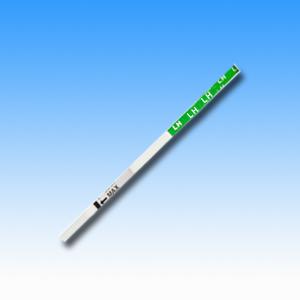DETECTION PRINCIPLE
The One Step FSH Test is a chromatographic immunoassay in-vitro diagnostic test for the qualitative detection.It adopts the principles of double antibody sandwich method to test the FSH in the urine.
SPECIMEN COLLECTION
1. Fresh urine does not require any special handing or pretreatment. Testing should be performed as soon as possible after the specimen collection, preferably during the same day.
2. The specimen may be refrigerated at 2-8℃ for 3 days or frozen at -20℃ for a longer period of time. Specimens that have been refrigerated must be equilibrated to room temperature prior to testing. Specimens previously frozen must be thawed, equilibrated to room temperature, and mixed thoroughly prior to testing.
TEST PROCEDURE
1. To begin testing, open the sealed pouch by tearing along the notch. Remove test kit from the pouch.
2. Hold the round end of cover with one hand. Use the other hand to pull out the test device and the expose the absorbent.
3. Point the absorbent tip downward, place the absorbent tip in urine stream for at least 10 seconds to be thoroughly wet. Otherwise, you can collect your urine into a clean cup, and dip half of the absorbent pad into the urine for at least 10 seconds.
4. Re-cap the device and wait for color band to appear. Read results within 5 minutes.
INTERPRETATION OF RESULTE
Negative: One pink/purple band forms in the control region; no band is found in the test region, or the color of the test band is less intense than that of the control/reference band.
Positive: Two pink/purple bands form, and the color of the test band is equal to or more intense than that of the control/reference band.
Invalid: If there is no pink/purple band in the control region, the test result is invalid. Retest the sample using a new device.

1. Over 99% accuracy
2. Simple to use
3. Store in room temperature
4. A variety of design specifications suitable for self-testing use and for professional use
5. 24 months shelf life
Q1: What's the method u use to do the test?
A: Colloidal Gold Method.
Q2: What's ur MOQ ?
A: Always, for strip format, the MOQ is 5000pcs. While for cassette format, MOQ is 2000pcs, same as midstream.
Q3: What's ur packing of the tests?
A: If u choose the low cost, we will suggest u the bulk packing to go. Which means 1 test in a single pouch, then 100/40 pouches in a plastic bag, 50 bags in a carton. If u need to sell in pharmacy/chain shop or some countries which have strict requirements about the packing, u can choose to pack in a box, like 100pcs in a box, or even 1 test in a single box.
Q4: What's the main differences when comparing products from different suppliers?
A: U can compare the mainly features of the test: Accuracy, Sensitivity, Specificity, and then the Price.
Q5: Some tests can be tested with serum/plasma or with whole blood, so what's the difference?
A: Well, if the specimen is whole blood, people will need buffer, lancet and alcohol swab to help the test. If they buy all the accessories, they can test very easily at home. But if the specimen is serum/plasma, it will need centrifuge to separate serum from whole blood first. This way, it's better to use at lab or hospital. And in some words, serum/plasma test will always give a more accurate results.
Q6: How can i distinguish a good test kit?
A: U can judge from the 4facts:Technical data: Such as the accuracy, specificity and sensitivity.
Pouch sealing: Tight enough. If the foil pouch is not sealed well, the humidity in circustance will destroy the reactivity of antibodies labeled on NC membrane. Shelf life will be shorten down.
Flow speed: The shorter the better?? NO!! The reaction of antibodies on NC membrane and antigens in specimen usually requires quite a while to work sufficiently. U can refer to the instruction for more accurate time.
Background: Good test usually gives clean background after running. If there are red smears in the reading window, it usually caused by bad colloidal gold technology or bad NC membrane. Sometimes, the defect caused false positive result in practice



